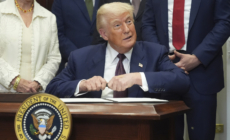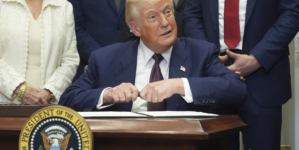-
Virginia Education Board Could Oust George Mason’s President - 11 mins ago
-
‘This fire could have been prevented.’ How California utilities fought removal of old power lines - 20 mins ago
-
California Moves Against State’s Insurer of Last Resort Over Smoke Policies - 27 mins ago
-
The Politics of Masks - 54 mins ago
-
The energy source that could survive Trump’s attack on California’s green ambitions - about 1 hour ago
-
Padres Shock National League, Claim Best Record in Post-Deadline Playoff Predictions - about 1 hour ago
-
trump-tariffs-debate-week-your-words – Newsweek - 2 hours ago
-
Mary Gaillard, Who Broke a Ceiling in Subatomic Research, Dies at 86 - 2 hours ago
-
Would Democrats run Kamala Harris — or any woman — in 2028? - 2 hours ago
-
America’s ‘Happiest’ Golfer Has a Timeless Message: Family First | Opinion - 2 hours ago
Threatened California High-Speed Rail Gets New Boost
California Governor Gavin Newsom has backed his state’s high-speed rail network with new legislation that could provide a new funding strategy.
It comes after President Donald Trump slashed $4 billion of federal funding for the project.
Newsweek contacted the California High-Speed Rail Authority for more information via email.
Why It Matters
California’s high-speed rail is in an awkward position. Years of delays and an inflated budget have damaged public and political faith in the project, but the past few years have seen progress—with construction happening throughout the state and tracklaying set to start later this year. To call off the project now, as many of its detractors in the White House desire, would waste years of advancement.
That has not stopped Trump, a long-standing critic of the project, from regularly threatening to take away the federal funding that has been vital to the project’s progress so far—a threat he and Transportation Secretary Sean Duffy carried out in July.
What To Know
On Wednesday, California Governor Gavin Newsom signed Assembly Bill 377, compelling the California High-Speed Rail Authority to submit a comprehensive funding strategy for the Merced-to-Bakersfield Central Valley segment in its upcoming 2026 business plan.
The new law directs the authority to update cost estimates, conduct risk assessments, and outline options for service initiation in this core section.
The high-speed rail project began as an ambitious $33 billion plan, approved by California voters in 2008 to connect San Francisco and Los Angeles in under three hours by 2020.
Today, the project’s cost estimates have surged to between $89 and $128 billion, and the initial phase is focused solely on a 171-mile stretch in the Central Valley, targeted for completion by 2033.

Getty Images
The legislative effort comes as the Trump administration officially revoked a $4 billion federal grant in July 2025, branding the project a “boondoggle” and arguing it failed to deliver on promises.
This action leaves California with the challenge of filling the resulting financial gap. Governor Newsom has proposed extending the state’s cap-and-trade program, which generates roughly $1 billion annually for the rail, by 15 years to 2045, ensuring a continued funding stream for the core segment.
State leaders are also debating simultaneous expansion north to Gilroy and south to Palmdale, which would better connect commuters to major metro areas via existing transit, provided lawmakers approve increased annual funding.
The California High-Speed Rail Authority has indicated that higher ridership from these links could incentivize private investment needed to finish the full system.
What People Are Saying
Governor Gavin Newsom defended the project and criticized the federal funding withdrawal, saying: “Trump wants to hand China the future and abandon the Central Valley. We won’t let him. With projects like the Texas high-speed rail failing to take off, we are miles ahead of others. We’re now in the tracklaying phase and building America’s only high-speed rail. California is putting all options on the table to fight this illegal action.”
Ian Choudri, CEO of the California High-Speed Rail Authority, said: “Canceling these grants without cause isn’t just wrong—it’s illegal. These are legally binding agreements, and the Authority has met every obligation, as confirmed by repeated federal reviews, as recently as February 2025.
“America’s only high-speed rail project underway is fast approaching the tracklaying phase, with 171 miles under active construction and design, 15,500 jobs created, and more than 50 major structures completed. This is no time for Washington to walk away on America’s transportation future.”
What Happens Next
The California High-Speed Rail Authority is expected to submit its updated business plan and comprehensive funding strategy to lawmakers in 2026. In the immediate term, state officials plan to pursue litigation to restore the lost federal grant and court private investment to close funding gaps.
Source link




















